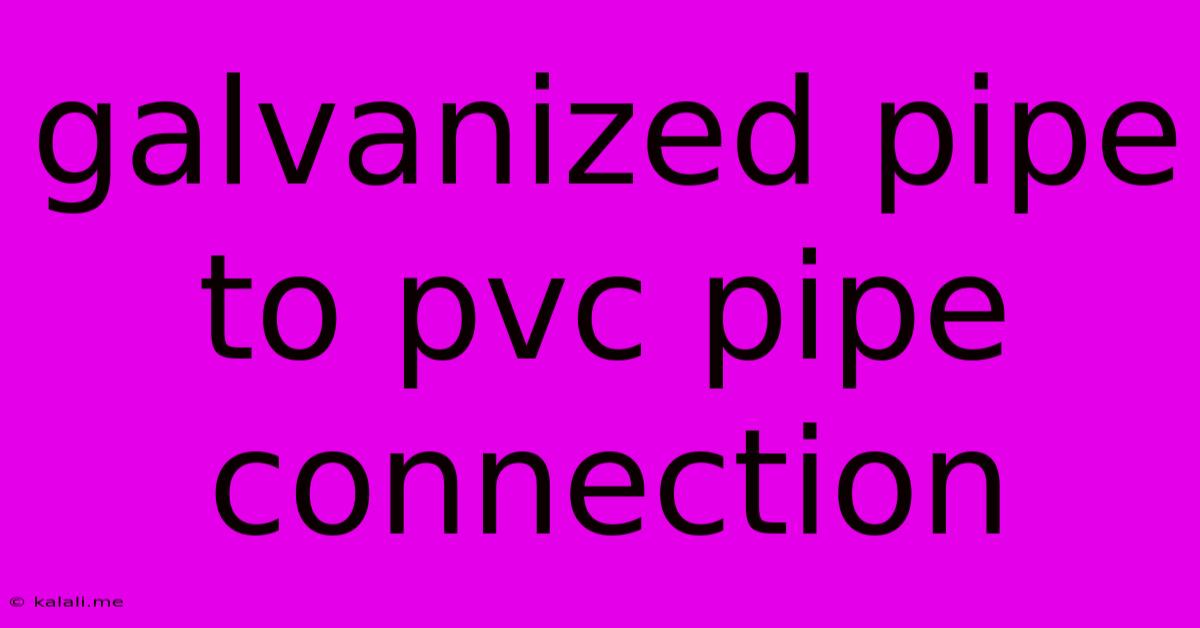Galvanized Pipe To Pvc Pipe Connection
Kalali
May 31, 2025 · 4 min read

Table of Contents
Connecting Galvanized Pipe to PVC Pipe: A Comprehensive Guide
Connecting galvanized steel pipe to PVC pipe requires a transition fitting because these materials are fundamentally different. Galvanized steel is a metal pipe known for its strength and durability, while PVC is a plastic pipe prized for its corrosion resistance and affordability. This guide will walk you through the process, covering the necessary materials, tools, and steps for a successful and leak-free connection.
Why You Might Need This Connection
Often, homeowners or contractors face this scenario when renovating older homes with galvanized plumbing systems. Perhaps you're upgrading a section of your plumbing to PVC for its corrosion resistance or to repair a damaged galvanized pipe section. Regardless of the reason, making a secure connection is crucial for preventing leaks and maintaining water pressure.
Materials You'll Need:
- Galvanized Pipe: Ensure the pipe end is clean and free of rust or debris.
- PVC Pipe: Make sure the pipe is correctly sized to match your fitting.
- Transition Fitting: This is the key component. You'll need a fitting that adapts from the galvanized pipe's diameter to the PVC pipe's diameter. Common options include:
- Galvanized to PVC Adapter: This is a simple fitting that directly connects the two pipe types.
- Dielectric Unions: These are especially useful to prevent galvanic corrosion, which can occur when dissimilar metals are in contact. They isolate the metal pipes, preventing corrosion.
- PVC Cement: A solvent-based adhesive that bonds PVC pipes and fittings securely.
- Teflon Tape (optional): While not strictly necessary for PVC connections, it can provide an extra layer of sealing, particularly on threaded connections.
- Pipe Cutter/Hacksaw: For cutting PVC or galvanized pipe to size.
- Pipe Wrench: To tighten fittings on galvanized pipes.
- Measuring Tape: For accurate measurements before cutting.
- Primer (for PVC): This helps the cement adhere properly to the PVC.
- Rags/Clean Cloths: For cleaning surfaces before applying cement.
Step-by-Step Guide:
- Prepare the Pipes: Clean both the galvanized and PVC pipe ends thoroughly. Remove any burrs, rust, or debris from the galvanized pipe. For PVC, ensure a clean and dry surface for proper adhesion.
- Choose the Right Fitting: Select the appropriate transition fitting based on your pipe sizes. Remember that dielectric unions are highly recommended to prevent galvanic corrosion.
- Assemble the Fitting: If using a threaded adapter, carefully apply Teflon tape to the threads of the galvanized side to ensure a watertight seal. Screw the adapter onto the galvanized pipe using a pipe wrench, tightening it securely but avoiding over-tightening. Avoid using excessive force; this can lead to damage.
- Prepare the PVC: Apply PVC primer to the end of the PVC pipe that will connect to the transition fitting, ensuring even coverage. Let it dry briefly according to the manufacturer's instructions.
- Apply PVC Cement: Apply a generous amount of PVC cement to both the inside of the fitting and the outside of the prepared PVC pipe.
- Connect the PVC: Quickly and firmly push the PVC pipe onto the fitting, twisting slightly to ensure a complete bond. Hold it in place for a few seconds to allow the cement to begin to set.
- Cure Time: Allow the PVC cement to cure completely according to the manufacturer's instructions. This usually takes several hours.
Important Considerations:
- Galvanic Corrosion: This is a crucial point. Using a dielectric union prevents the interaction between the galvanized steel and the PVC, significantly reducing the risk of corrosion and extending the life of your plumbing system.
- Proper Sizing: Using incorrectly sized fittings will create leaks and compromise the structural integrity of the connection.
- Safety First: Always wear appropriate safety gear, including gloves and eye protection, when working with plumbing materials and tools.
Troubleshooting:
- Leaks: If you experience leaks after the cure time, double-check the connections and ensure the fittings were properly tightened and glued. You may need to redo the connection if necessary.
By carefully following these steps and using the appropriate materials, you can successfully connect galvanized pipe to PVC pipe, creating a durable and leak-free plumbing connection. Remember to always prioritize safety and use the correct tools and techniques for a successful project.
Latest Posts
Latest Posts
-
How To Increase Artboard Size In Illustrator
Jun 01, 2025
-
Exponential Distribution Expected Value Failure Rate
Jun 01, 2025
-
Where Can I Sell A Diamond Ring
Jun 01, 2025
-
15 Or 20 Amp Gfci For Bathroom
Jun 01, 2025
-
Why Is Simon Called Peter In The Bible
Jun 01, 2025
Related Post
Thank you for visiting our website which covers about Galvanized Pipe To Pvc Pipe Connection . We hope the information provided has been useful to you. Feel free to contact us if you have any questions or need further assistance. See you next time and don't miss to bookmark.